Anchor worms in fish are a type of parasitic worms having anchor type structure. The causative agent is Lernaea sp. They attach themselves to the fish’s flesh with a sharp, anchoring head.
Anchor worms attach themselves to the fish’s body with their large, hooked claws and feed on the fish’s blood. They are responsible for millions of dollars in losses to the aquaculture industry every year.
Signs that a fish may have redness, inflammation, and lesions on the skin. These parasites are easy to identify, and you can treat them with a variety of methods.
Here the article will provide a deep brief on the causes, symptoms, prevention, and treatment.
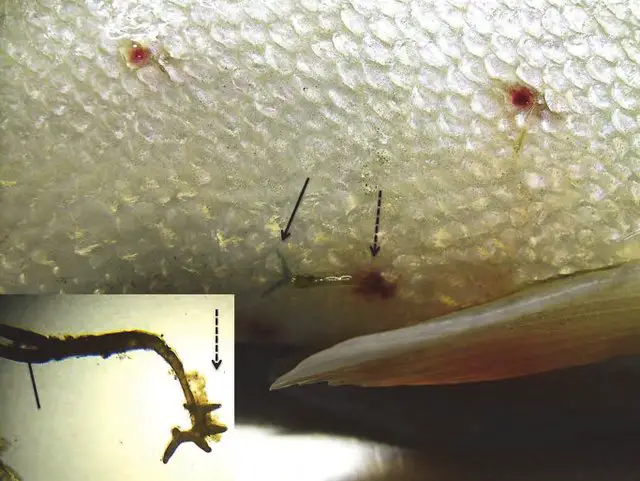
Source: Researchgate.net
What is Anchor Worm in Fish?
Anchor worm is a parasite having anchor type structure on the posterior side of the body.
This anchor type structure and anchoring nature into the fish skin (burrows deep into the fish’s body) called them “Anchor Worm”. The diseases is known as anchor worm disease or lernaeasis.
The Lernaea cyprinacea (Linnaeus) crustaceans species is called anchor worm that typically infect freshwater fish and cause bodily distress and mortality.
Around 110 genera of lernaeids have been noted. Among them, Lernaea cyprinacea is more commonly identified and observed in the culture system.
These parasites belong to the crustacean subphylum (Phylum-Arthropoda) and Copepoda sub class.
Where Do Anchor Worms Attach?
They can attach themselves anywhere on your cultured or pet fish including skin, fins (dorsal, pectoral, pelvic and tail) and gills.
They typically burrow into the skin, flesh, or gills of the fish to anchor themselves. These parasites have a characteristic long and slender body, with a hook-like structure at one end, which they use to firmly attach to the host fish.
The attachment points can vary, but they often target areas such as the fish’s body, fins, or gills.
They attach the gill tissues to the gill arch bone and gill filaments leading to mechanical damage and negative physiological effects.
Taxonomic Classification of Lernaea sp.
- Kingdom: Animalia
- Phylum: Arthropoda
- Subphylum: Crustacea
- Class: Maxillopoda
- Subclass: Copepoda
- Order: Caligoida
- Family: Lernaeidae
- Genus: Lernaea
- Species: L. cyprinacea
Source: Linnaeus, 1758
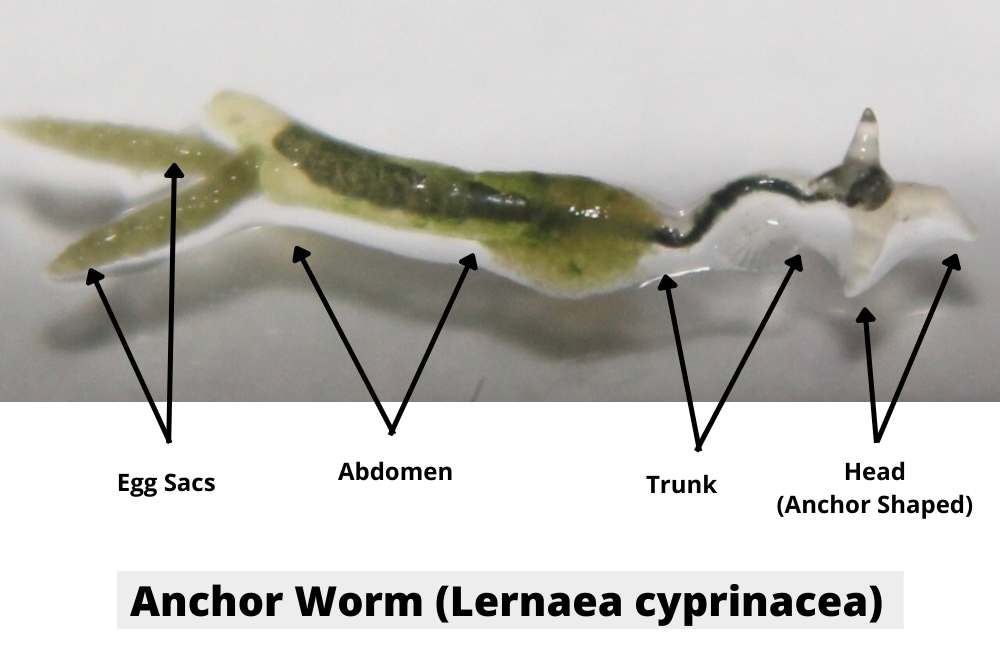
Geographical Distribution
These parasites are most commonly found in tropical and subtropical regions, but can also be found in temperate climates.
They tend to cause problems in summer when water temperatures are warmer.
It is believed to originate primarily from Asia, particularly Japan, yet it has established a broad presence across the globe, spanning regions such as Europe, Africa, Australia, North America, and South America.
This parasite has the capacity to infest a diverse array of teleost fish, affecting over 100 species, as well as amphibians.
Species Affected
- Major carps (Indian & Chinese),
- Minor barbs
- Catfish
- Perches
What does an anchor worm look like? | Body Features (Morphology or Characteristics) of a Typical Lernaea
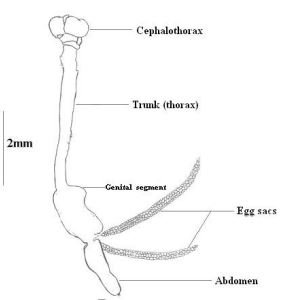
They are typically gray or white in color and can grow up to two inches (20 mm) long. They have a slender body having an attachment organ in their posterior end.
Female worms are one of nature’s most bizarre creatures having pair of sacs when female mature into adult.
They burrow into the flesh of a fish and transform into an unsegmented, wormlike form, usually with a portion hanging from the fish’s body; they can be as long as 1 cm.
Anchor worms can be identified by their long, white body and brown head. They range in size from 2 to 6 inches in length.
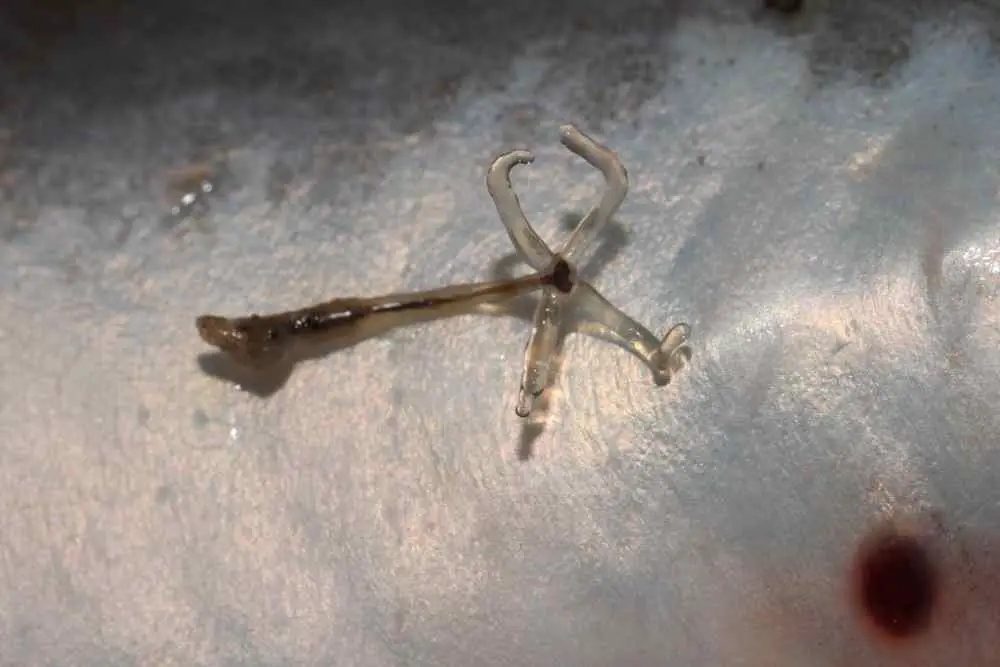
Most copepods have a long body but they can also have a short body.
It is a long, white worm with a small head and a large tail that attaches itself to the flesh of the fish with a sharp-pointed head.
These parasites use their sharp mouthparts to pierce the skin of their host fish and feed on the blood and tissues.
Life Cycle of Lernaea (Anchor Worm)
The entire life cycle (25 days) of Lernaea includes several stages. These stages of the parasite are,
1. Egg
Adult female having pair of egg sac from where they release eggs (250 eggs) at 25 degree celsius temperature, which are typically attached to the fins or scales of the host fish. The eggs are oval-shaped and are usually about 0.5 mm in diameter.
2. Nauplius and Metanauplius
After hatching of eggs, the first larval stage (first copepodid stage) is the free-living nauplius (singular; nauplii). This stage is characterized by a single eye, three pairs of appendages, and a small tail. They are known as free swimming juveniles.
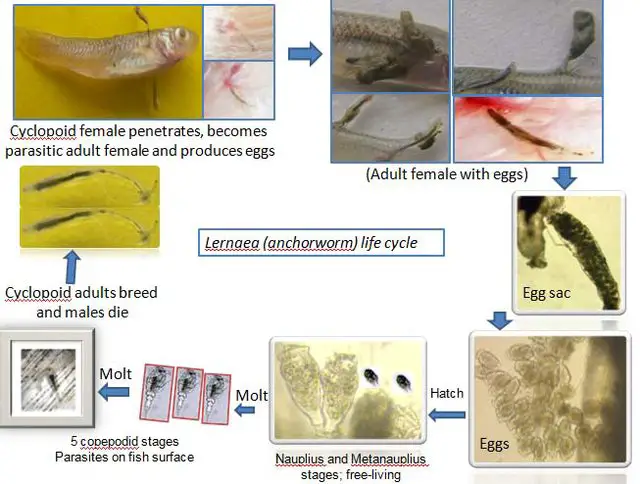
3. Copepodid
The next stage is the copepodid, which is similar in shape to the adult but smaller. This stage typically has five pairs of appendages and a long tail.
They develop through five different copepodid stages in about four days before molting into their first parasitic stage and attaching to fish or amphibians, often on gills.
4. Cyclopoid Adult
The final copepodid stage is the cyclopoid adult, which is characterized by a distinctive head and thorax, a large body, and five pairs of appendages.
Adult females are typically larger than adult males. Adult male dies after reproduction and female attached to the fish skin and female remain parasitic. They use fish host to complete their life cycle. They also found in the gill and permanently embedded in the tissue.
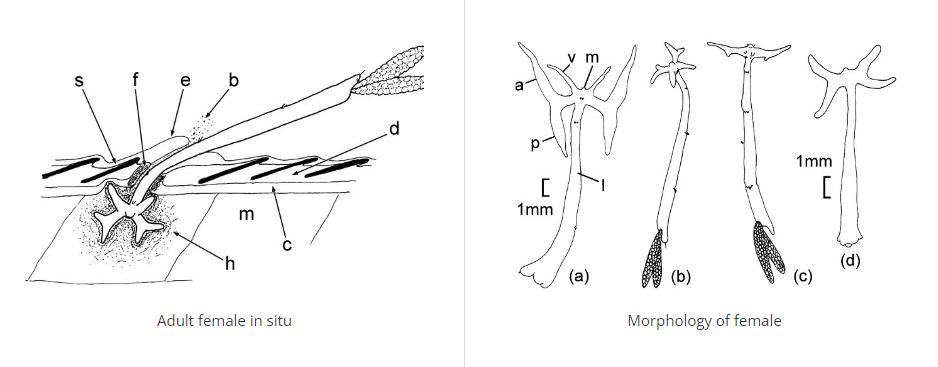
What Causes Anchor Worm in Fish?
1. Poor Water Quality
Anchor worms can take advantage of weakened or stressed fish, so poor water quality (e.g. high levels of pollution, disturbed water parameters, low oxygen levels) can make fish more susceptible to infection.
Basically, the parasitic worms burrow into the injured or affected areas of fish’s body which is often caused by contact with muddy or dirty water as this provides them nourishment.
2. Water Temperature
Anchor worms thrive in warm water, so infestations are more likely to occur in the summer months. These worms thrive in warm water and are less prevalent in cooler climates.
3. Fish Density
Anchor worms are more likely to spread in crowded conditions, such as in overstocked ponds or aquariums. High stocking density deteriorate the water conditions accelerate the abundance of these types of parasites.
4. Immune Suppression
Certain medications, changes in pH and other stressors can suppress the fish’s immune system, leaving them vulnerable to anchor worm infestations.
Additionally, certain types of fish are more susceptible to anchor worm infestation than others.
5. Introduction of infected fish
Anchor worms can also be introduced to a pond or tank through infected fish, which can then spread the parasites to other fish in the system.
6. Presence of Suitable Intermediate Host
The presence of suitable intermediate hosts accelerate their life cycle. They prefer to parasitize fish, and sometimes infest amphibians and reptiles.
Signs and Symptoms of Anchor Worm
Anchor worms are small and thin creatures that attach themselves to the flesh of fish using their strong hooks. They can be identified with the naked eye.

-A visible pale thread-like organism protruding from the fish’s skin. They do this by burrowing through it, creating lesions that can allow secondary bacterial and viral infections that lead to severe infestations.
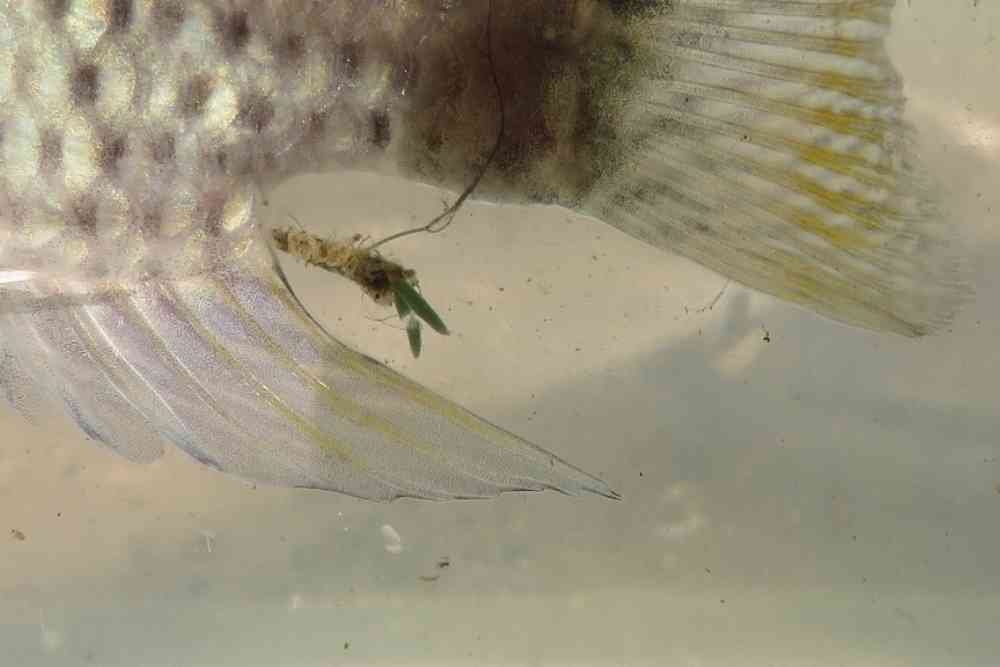
-Scratching or rubbing abnormally against objects in the aquarium or pond.
-Redness, inflammation, and lesions on the skin leading leading to infection, tissue death, and even death.
–Excessive lethargy, and loss of appetite. In severe cases, they can actually cause gill damage that causes death in some infestations.
Diagnosis of Anchor Worms
Morphometric Identification
They are not difficult to diagnose, as they are visible to the naked eye.
These tiny creature look like small pieces of string or thread and no need to observe in microscope.
The best way to tell if your fish has an anchor worm is by looking for the worm’s “head” on the fish’s body.
If you see a small, brown spot on your fish that looks like a head, then there is a good chance that your fish has an anchor worm.
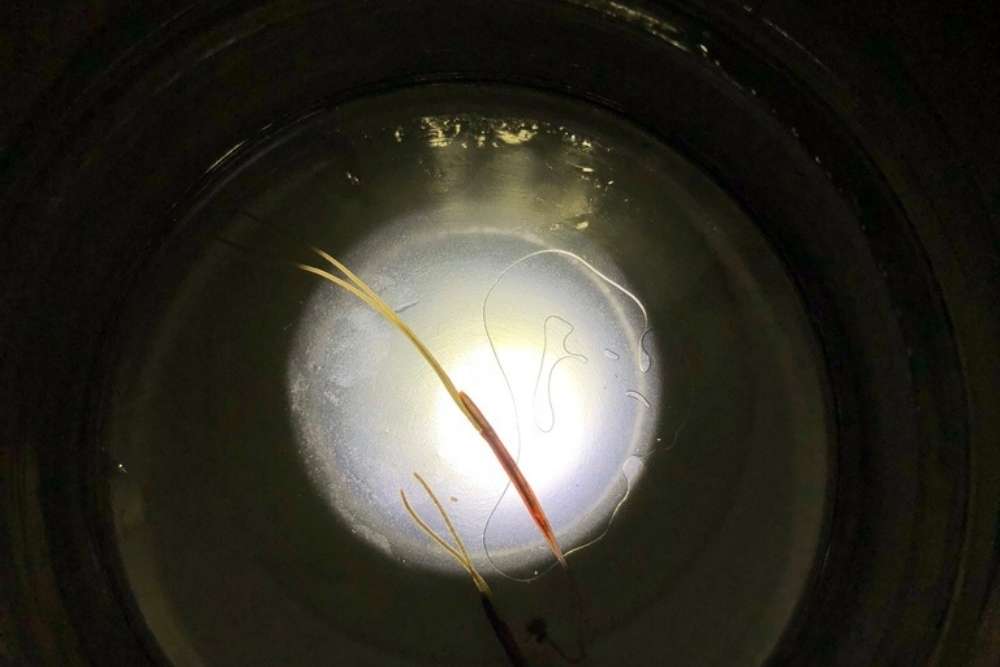
Molecular Identification
To confirm the species molecular identification is necessary. Molecular identification also helpful for providing specific treatment.
DNA barcoding is one of the best method to identify a parasitic species. In that case collected parasitic sample go through several laboratory steps (i.e., DNA extraction, DNA purification, PCR, Gel electrophoresis and DNA sequencing).
The final DNA sequenced result then compare with previously documented sequenced result to verify the specific species.
Besides, costly whole genome sequencing process accurately identify the species. This types of sequencing basically conducted for research purposes not for regular parasite identification.
How To Prevent Anchor Worm in Fish
1. Test and Maintain Good Water Quality
Use proper and accurate water quality checking kit to observe the water quality parameter (pH, ammonia, nitrite and nitrate).
If the test results indicate that the water parameters are outside of the optimal range, you may need to take action to improve the water quality.
For example, if the pH level is too high or too low, you may need to add pH adjusters to bring it within the appropriate range.
If the ammonia, nitrite, or nitrate levels are too high, you may need to perform water changes, add beneficial bacteria or use appropriate water treatments to reduce the levels.
2. Disinfect Equipment
To prevent an infestation, it is important to practice good hygiene when handling bait or live fish and to properly clean and disinfect any equipment that comes into contact with water.
Anglers should take care to properly clean their gear after each outing.
3. Use Proper Water Filtration
Maintaining good water quality is crucial in preventing fish parasite abundance.
Poor water quality can stress fish and weaken their immune system, making them more susceptible to parasites.
Along with water testing, regular pond maintenance such as removing debris, adding beneficial bacteria, and monitoring fish health can also contribute to preventing fish parasite abundance.
4. Quarantine New Fish
Quarantine any new fish before adding them to your aquarium or pond. This will help protect your other fish from potential infection.
Anchor Worm Treatment | How Do You Remove Anchor Worms?
There are several physical, chemical and biological treatments available that can help control, kill or remove Lernaea in your tank.
:
1. Manual Removal or Picking off Worms
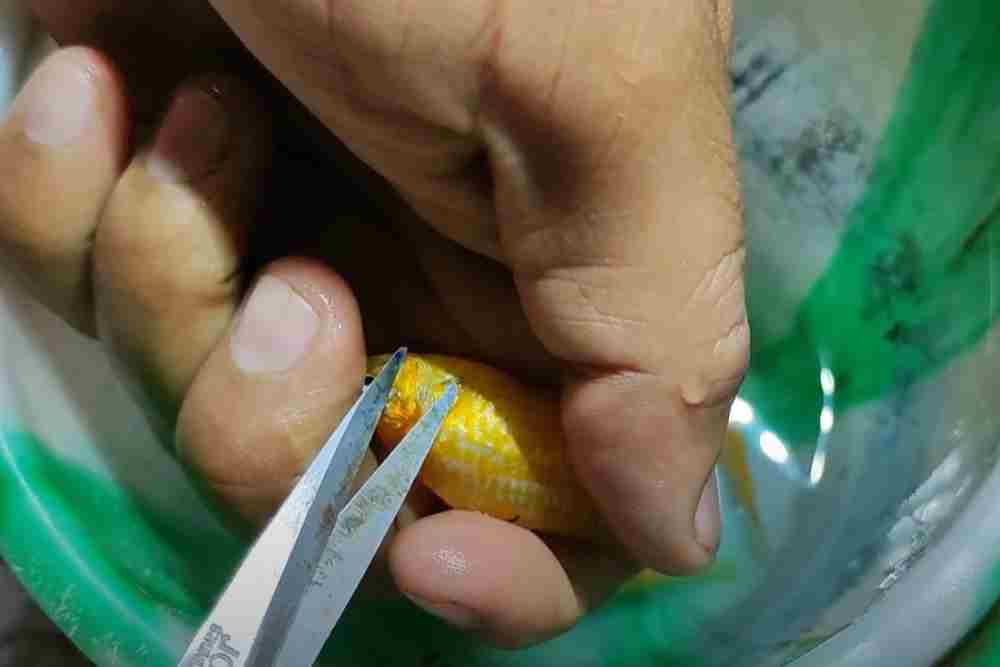
You can manually remove adult Lernaea parasites from your fish using fine-tipped tweezers or a similar tool.
Be sure to disinfect the tool and the affected area on the fish to prevent infection.
There are several methods that can be used to pick off them. One way to remove an anchor worm is to use a hook or pliers.
- Hook the worm near the head and pull it off. If using pliers, grip the worm as close to the head as possible and twist until it comes off.
- To pick off anchor worms, pinch off the worm head and pull the body in opposite direction.
- One can hold the fish in their hand and remove them with a pair of tweezers.
- However, it is important not to break off the tail or head while removing them because if that happens then they will be left embedded in fish skin.
- Another method is to use a sharp knife or razor blade. Cut the worm near the head and pull it off. Be careful not to cut yourself in the process.
2. Change the Poor Water
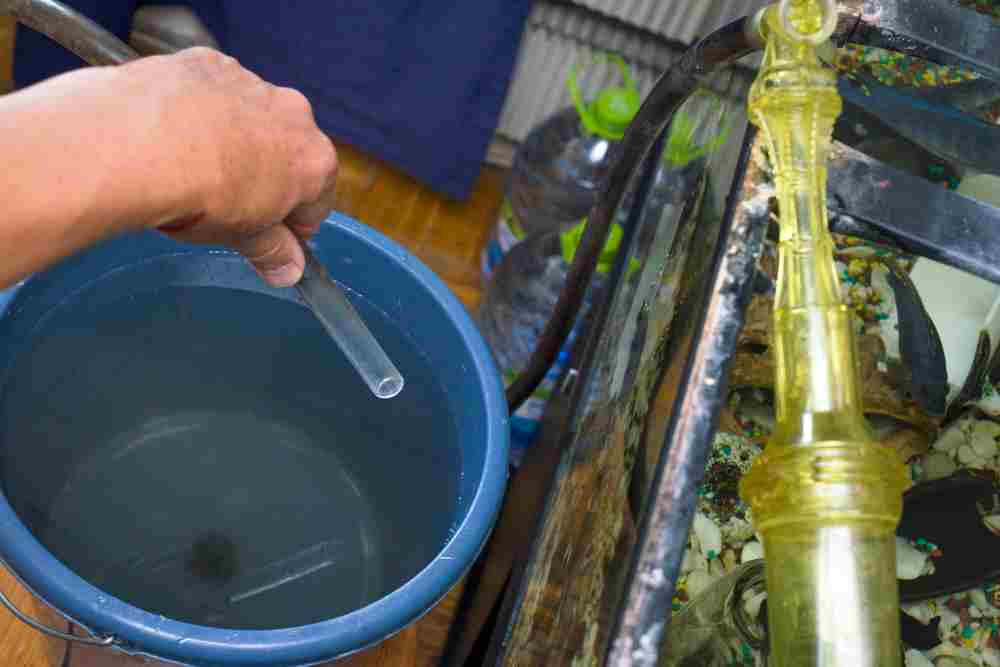
- Anchor worms reproduce through eggs, so treatment should be applied throughout the entire aquarium, which may disrupt the aquarium’s cycling.
- The first thing you need to do when dealing with a fish disease or infection is changing the water. By doing so, your aquarium will be in good condition for healing and not have any toxic water conditions that would otherwise harm them even more.
3. Salt Bath Treatment
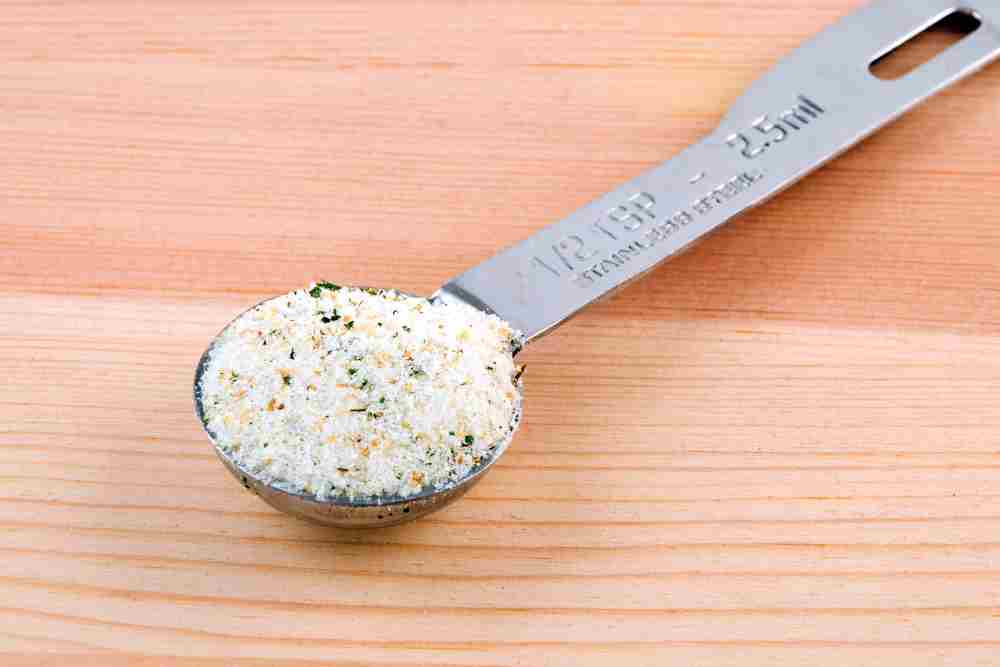
- Put the infested fish into your water at 1-2 tablespoons of salt (sodium chlorite NaCl) which may help prevent secondary infections if they happen to come up later on down the line too.
- Another option is to make your own treatment using Epsom salt and garlic cloves. To do this, dissolve 1 cup of Epsom salt in 1 gallon of water.
- Cut up 2-3 cloves of garlic and add them to the solution. Soak your fish in the solution for 10-15 minutes, then rinse them off with fresh water.
4. Potassium Permanganate Treatment

- Potassium permanganate (5-10 ppm) is usually considered the best treatment and works in aquariums or fish ponds. Potassium permanganate is a strong oxidizing agent that is used to treat anchor worms. It works by killing the parasites that are attached to the fish. Potassium permanganate can be added to the aquarium water or it can be used as a dip.
- It is important to follow the instructions carefully when using potassium permanganate, as it can be toxic if not used correctly.
5. Formalin
- Formalin can be used for baths at a concentration of 200 ppm, but these baths should be done separately, as the eggs in the tank can still be dangerous. Caution is needed if the fish has open wounds or is struggling.
6. Temperature Control
- Lernaea parasites are more active in warmer water. Lowering the water temperature slightly can help slow down their life cycle and reduce their reproduction rate.
7. Biological Control
- Some fish species, such as certain species of catfish or cleaner fish, can help control copepod populations by feeding on them. Introducing these fish to your tank can be a natural way to combat the parasites.
8. Regular Cleaning
- Regularly clean the tank or aquarium, including substrate and decorations, to remove any potential hiding places for Lernaea parasites.
Anchor Worms in Aquarium Fishes

This external parasite also found on the gill and skin of different aquarium fishes, particularly goldfish and koi. In smaller-sized fish, infections can be fatal.
Anchor worms lay their eggs at the end of their bodies, and these eggs mature rapidly, usually within 14 days in the aquarium. Larvae initially attach themselves to the fish’s gills.
During their growth and maturity, the feed on the host fish’s blood, which can lead to injuries and muscle destruction.
Infected fish may rub against objects in the aquarium and become agitated.
Wounds caused by anchor worms are difficult to heal, so prompt action is necessary to prevent their breeding and proliferation.
Anchor Worm in Freshwater Fish Pond
Anchor worm infestations in freshwater fish ponds are a concern in the USA, as they can affect the health of fish populations. Lernaea, commonly known as anchor worms, are parasitic copepods that can attach themselves to fish in pond environments.
Treating anchor worms (Lernaea) in a pond requires a systematic approach to eliminate the parasites and prevent their return. Here’s a step-by-step guide on how to treat anchor worms in a pond:
- Isolate Infected Fish:
- If you observe fish with visible anchor worms or suspect an infestation, isolate them in a separate quarantine tank or temporary holding container within the pond. This prevents the spread of the parasites to other fish.
- Physical Removal:
- Use fine-tipped tweezers or forceps to carefully remove the visible anchor worms from the infected fish. Be gentle to avoid causing additional stress or injury to the fish.
- Disinfect the removal tool between each use to prevent cross-contamination.
- Apply Topical Treatment:
- Apply a topical treatment directly to the affected areas on the fish. Several treatments are available, such as potassium permanganate or hydrogen peroxide. Follow the manufacturer’s instructions for dosage and application methods.
- Make sure the treatment comes into contact with the anchor worms to kill them. Repeat the treatment as needed, following the recommended schedule.
- Treat the Pond Water:
- To target anchor worms in the pond water and prevent reinfestation, consider using a pond-safe anti-parasitic treatment. Formalin and praziquantel are commonly used chemicals for this purpose.
- Follow the manufacturer’s instructions carefully to calculate the correct dosage based on your pond’s volume. Apply the treatment evenly throughout the pond.
- Ensure proper aeration during and after treatment to maintain oxygen levels for your fish.
- Maintain Water Quality:
- Continue regular maintenance of your pond’s water quality. Clean the filter, remove debris, and perform partial water changes as necessary.
- Adequate water quality helps reduce stress on fish and minimizes the risk of future infestations.
- Quarantine New Additions:
- Quarantine any new fish or plants before introducing them to the pond to prevent the introduction of anchor worms or other parasites.
- Monitor and Repeat:
- Regularly inspect your fish for any signs of anchor worm reinfestation. If you detect new infestations, repeat the treatment process promptly.
- Fish Health and Nutrition:
- Maintain a balanced diet for your pond fish to boost their immune systems and overall health. Healthy fish are better equipped to resist infections.
- Prevent Future Infestations:
- Minimize the risk of anchor worm infestations by practicing good pond hygiene, maintaining optimal water parameters, and avoiding overstocking.
- Consult a Professional:
- If the infestation is severe or persistent, or if you’re unsure about the treatment process, consult with a local aquatic veterinarian or a pond specialist for expert advice and guidance.
Frequently Asked Questions (FAQs)
Do anchor worms fall off?
If you remove an anchor worm from a fish’s skin yourself, the worm will die. Others maintain that the anchor worm will eventually detach itself from the host’s flesh and fall off on its own.
How many days do anchor worms live without a host?
Anchor worms can live without a host for up to 10-12 days but will die within 2-3 days if they do not find a host.
Are anchor worms infect (harmful) for human?
Can humans get anchor worms from fish? Although anchor worms are not known to specifically target humans as a host, they are still capable of infecting us. There is no evidence that they can infect humans.
They are not harmful as worms may die when cooked for eating, if remain in fish body.
Can anchor worms kill fish?
While they may not always kill their host, they can reduce growth somewhat. This can be a major issue for commercial fisheries, as smaller fish yield less profit.
Where does anchor worm comes from?
Copepods are a type of crustacean that mostly lives in water. They are found in freshwater environments.
How did anchor worms get in my fish tank?
They can introduced into a fish tank by way of infected bait or live fish. Once introduced, they can quickly become established and cause significant harm to the fish population.
In most cases, they are introduced into a fish tank when a new fish is added to the tank. They can also be spread through contaminated water or food.
Can betta fish get anchor worms?
Yes, betta fish can potentially get anchor worms (Lernaea), although it’s not as common in bettas compared to some other fish species.
Anchor worms are external parasites that can attach themselves to various freshwater fish, and while they may not be a typical infestation in bettas, it’s essential to monitor your betta fish for any signs of parasitic infections.
Can marine fish get anchor worms?
Yes, marine fish can also get anchor worms (Lernaea). While anchor worms are more commonly associated with freshwater fish, these parasitic copepods can potentially infest marine fish as well, especially in instances where the conditions allow for such infestations.
It’s important to be vigilant and monitor the health of your marine fish for any signs of anchor worm infestations, as early detection and treatment are essential to ensure the well-being of the fish in your marine aquarium.
References
- Linnaeus, C. (1789). Systema Naturae per regna tria naturae, secundum classes, ordines, genera, species; cum characteribus, differentiis, synonymis, locis (Vol. 1). apud JB Delamolliere.
- Steckler, N., & Yanong, R. P. (2012). Lernaea (Anchorworm) infestations in fish. Institute of Food and Agricultural Sciences. University of Florida. FA-185.
- Hossain, M. M. M., Rahman, M. Z., Islam, M. A., Alam, M. E., & Rahman, H. (2013). Lernaea (anchor worm) investigations in fish. Int J Anim Fish Sci, 1(1), 12-19.
- Dempster, R. P., Morales, P., & Glennon, F. X. (1988). Use of sodium chlorite to combat anchorworm infestations of fish. The Progressive Fish-Culturist, 50(1), 51-55.
- Kadhim, R. A. (2009). Resistance of common carp fishes Cyprinus carpio (L.) to reinfection by anchor worm Lernaea cyprinacea (L.). Al-Qadisiyah Journal of Science, 14(3), 49-58.
- Hossain, M. M. M., Ferdoushi, J., & Rupom, A. H. (2018). Biology of anchor worms (Lernaea cyprinacea). Journal of Entomology and Zoology Studies, 6(1), 910-917.
- Tamuli, K. K., & Shanbhogue, S. L. (1996). Efficacy of some commonly available chemicals in the treatment of anchor worm (Lernaea bhadraensis) infection. Environment and Ecology, 14(2), 259-267.
- Tamuli, K. K., & Shanbhogue, S. L. (1996). Incidence and intensity of anchor worm Lernaea bhadraensis infection on cultivated carps. Environment and Ecology, 14(2), 282-288.
- Al-Marjan, K. S., & Abdullah, S. M. (2008). Experimental study of the life cycle of the anchor worm Lernaea cyprinacea Linnaeus, 1758. J. Duhok Univ, 11(2), 110-116.
- James MacHale, J. S., & Hedley, J. (2021). Successful Treatment of Anchor Worm (Lernaea cyprinacea) Using Lufenuron in the Mexican Axolotl (Ambystoma mexicanum). Journal of Herpetological Medicine and Surgery, 31(2), 107-110.
- Kearn, G. C. (2004). Cyclopoid copepods–the anchor worm. Leeches, Lice and Lampreys: A Natural History of Skin and Gill Parasites of Fishes, 208-213.
- Koesomadinata, S., Rukyani, A., Qomaruddin, O., & Djajadiredja, R. (1981). Some aspects on the biology and control of the anchor worm (Lernaea cyprinacea) in Indonesia: final technical report.
- Al-Hamed, M. I., & Hermiz, L. (1973). Experiments on the control of anchor worm (Lernaea cyprinacea). Aquaculture, 2, 45-51.
- Al-Dulaimi, F. H., Mhaisen, F. T., & Al-Zubaidy, A. B. Effect of Artemisia herba-alba water extract in treating the common carp Cyprinus carpio infected with the anchor worm Lernaea cyprinacea.
- Sanchez-Hernández, J. (2017). Lernaea cyprinacea (Crustacea: Copepoda) in the Iberian Peninsula: climate implications on host–parasite interactions. Knowledge & Management of Aquatic Ecosystems, (418), 11.
- Berry Jr, C. R., Babey, G. J., & Shrader, T. (1991). Effect of Lernaea cyprinacea (Crustacea: Copepoda) on stocked rainbow trout (Oncorhynchus mykiss). Journal of Wildlife Diseases, 27(2), 206-213.
- McAllister, C. T. (2011). Lernaea cyprinacea (Crustacea: Copepoda: Lernaeidae) anchorworms from two larval aquatic insects (Ephemeroptera: Baetidae: Trichoptera: Hydropsychidae) in northeastern Oklahoma. In Proceedings of the Oklahoma Academy of Science (pp. 37-40).
- Perveen, F., & Ullah, H. (2013). Ectoparasites of indigenous and exotic fresh water carp fish (Cypriniformes: Cyprinidae) from Charbanda and Tarbela, Khyber Pakhtunkhwa, Pakistan. Pak Am J Res Commun, 1(9), 255-269.
- Khalifa, K. A., & Post, G. (1976). Histopathological effect of Lernaea cyprinacea (a copepod parasite) on fish. The progressive fish-culturist, 38(2), 110-113.
- Khalifa, K. A., & Post, G. (1976). Histopathological effect of Lernaea cyprinacea (a copepod parasite) on fish. The progressive fish-culturist, 38(2), 110-113.
- Pallavi, B., Shankar, K. M., Sathish, R. P., Ramesh, K. S., & Prabhudev, K. N. (2016). Evaluation of loss in terms of mortality and growth reduction in Catla catla (Hamilton, 1822) under experimental infection of anchor worm. Indian Journal of Fisheries, 63(1), 132-134.
- Afriandini, W., & Suwartiningsih, N. (2021). Prevalence and Intensity of Anchor Worm (Lernaea cyprinacea L.) Ectoparasite in Koi Fish (Cyprinus carpio L.) at Bantul Koi Farm DI Yogyakarta. Journal of Biotechnology and Natural Science, 1(1), 33-40.
- Jha, D. K., & Bhujel, R. C. (2012). Incidence of fish diseases and management practices in Nepal. Small-scale Aquaculture for Rural Livelihoods, 160-165.
- Acosta, A. A., Carvalho, E. D., & da Silva, R. J. (2013). First record of Lernaea cyprinacea (Copepoda) in a native fish species from a Brazilian river. Neotropical Helminthology, 7(1), 7-12.
- Subsukul, Y. (1976). Study of the infestation of certain species of fresh water fish by the anchor worm (Lernaea cyprinacea)[in Thailand].
- Lewis, W. M. (1961). Benzene Hexachloride vs. Lindane in the Control of Anchor Worm. The Progressive Fish-Culturist, 23(2), 69-69.
- Waldman, J. (2017). A novel three-way interaction among a fish, algae, and a parasitic copepod.
- Mhaisen, F. T., & Abul-Eis, E. S. (2015). Parasites of the common cart Cyprinus carpio in the Babylon fish farm, Hilla, Iraq.
- Furtado, W. E., Cardoso, L., Figueredo, A. B., Marchiori, N. C., & Martins, M. L. (2019). Histological and hematological alterations of silver catfish Rhamdia quelen highly parasitized by Lernaea cyprinacea. Diseases of Aquatic Organisms, 135(2), 157-168.
- Mhaisen, F. T., & Abdul-Ameer, K. N. (2021). Checklist of fish hosts of species of Lernaea Linnaeus, 1758 (Hexanauplia: Cyclopoida: Lernaeidae) in Iraq. Biol. Appl. Environ. Res, 5(1), 53-73.
- Klinger, R. E., & Floyd, R. F. (1998). Introduction to freshwater fish parasites. Gainesville: University of Florida Cooperative Extension Service, Institute of Food and Agriculture Sciences, EDIS.
- Meyer, F. P., Hoffman, G. I., & Hoffman, G. L. (1976). Parasites and diseases of warmwater fishes (Vol. 127). US Department of the Interior, Fish and Wildlife Service, Fish Farming Experimental Station.
- Wildgoose, W. (1998). Skin disease in ornammental fish: identifying common problems. In Practice, 20(5), 226-243.
- Goodwin, A. E. (1999). Massive Lernaea cyprinacea infestations damaging the gills of channel catfish polycultured with bighead carp. Journal of Aquatic Animal Health, 11(4), 406-408.
- Misganaw, K., & Getu, A. (2016). Review on major parasitic crustacean in fish. Fisheries and Aquaculture Journal, 7(3), 1-6.
- Durham, B. W., Bonner, T. H., & Wilde, G. R. (2002). Occurrence of Lernaea cyprinacea on Arkansas River shiners and peppered chubs in the Canadian River, New Mexico and Texas. The Southwestern Naturalist, 47(1), 95-98.
- Sridhar, N., & Raghunath, M. R. (2006). Efficacy of nine laboratory chemicals against the free living developmental stages of Lernaea cyprinacea. Journal of Veterinary Parasitology, 20(1), 37-40.
- Heckmann, R. I. C. H. A. R. D. (2003). Other ectoparasites infesting fish: Copepods, branchiurans, isopods, mites and bivalves. AQUACULTURE MAGAZINE-ARKANSAS-, 29(6), 20-31.
- Kadhim, R. A. (2009). Resistance of common carp fishes Cyprinus carpio (L.) to reinfection by anchor worm Lernaea cyprinacea (L.). Al-Qadisiyah Journal of Science, 14(3), 49-58.
- Steckler, N., & Yanong, R. P. (2013). Lernaea (Anchorworm) Infestations in Fish: FA185, 12/2012. EDIS, 2013(2).
5 thoughts on “Anchor Worms In Fish: Causes, Signs & Treatment”
Comments are closed.